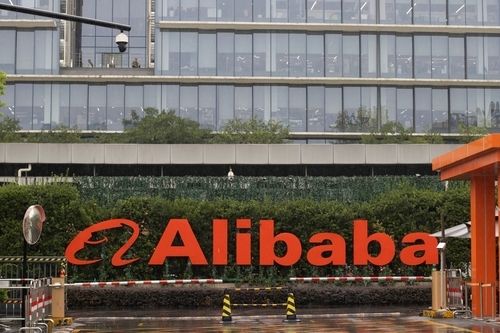Alibaba's AI Reboot: The Undervalued Bet on China's Cloud Leader


- Alibaba Cloud’s non-GAAP revenue grew 11% YoY, with AI products posting triple-digit growth for six straight quarters, driven by surging enterprise inference demand.
- Q4 CapEx hit RMB 31 billion, more than doubling QoQ, marking the start of a historic three-year AI infrastructure supercycle surpassing the last decade’s total spend.
- Valuation remains depressed at ~8x forward non-GAAP earnings, despite $51.9B in net cash and 5% share count reduction in the last 9 months.
- Core e-commerce rebounded with 9% YoY CMR growth and 49 million 88VIP members, driving EBITA gains while maintaining a user-first experience.
TradingKey - Alibaba Group (BABA) is experiencing a rebirth, one that investors are inclined to discount as a cyclical reversal of fortunes instead of a structural realignment. But beneath the surface, there's a tectonic shift: The company is incrementally rebuilding its core on an axis of “AI + Cloud,” with impact possibilities to redefine its moat and long-term multiple. While the market continues to stay preoccupied with China's consumer-demand headwinds and overhangs from regulators, Alibaba is setting its stage to own Asia's AI infrastructure layer by leveraging a strategic combination of sovereign-scale cloud, foundation models, and application-layer convergence.
What turns this inflection point asymmetric, however, is the mixture of depressed valuation (trading only ~8x forward non-GAAP earnings with 5% reduction in share count over last 9 months) and company transition from defensive cost cutting into offensive CapEx. With more than $51.9 billion in net cash and aggressive divesting of legacy retail assets such as Sun Art and Intime, Alibaba is redeploying capital into China's biggest AI infrastructure build-outs in history. Not only are we aligning the company with secular AI themes globally, but also setting it up to become Asia's analogue to AWS, monetizing compute, model, and ecosystem layers simultaneously.
The case for investment here isn't if and when Alibaba's e-commerce growth revives, after all, it has already done so. It's if investors think that the "AI + Cloud" strategy can achieve lasting operating leverage in a world where Tencent and Baidu are still siloed. The months ahead may unlock Alibaba's least understood shift since its listing.
.png)
Source: Ycharts
Core Reloaded: How Alibaba Is Redefining Around E-Commerce and “AI + Cloud”
A disciplined cycle of contraction and expansion of its business model, reducing its sprawl while doubling down on scalable profit centers, is working its way through Alibaba. The contraction phase is almost over: last year, it divested non-core assets such as offline retails assets (e.g., Sun Art, Intime), reduced its capitals footprint, and shut unprofitable operations such as some of its logistics businesses. The resultant re-focusing of its business has brought three pillars into balance: domestic and international e-commerce, “AI + Cloud,” and internet platform businesses
E-commerce continues to form the bedrock. Local sites Taobao and Tmall posted customer management revenue (CMR) growth of 9% YoY in Q4 2024 with robust GMV growth and better monetization tools such as the “Quanzhantui” ad engine. Membership also increased significantly: premium 88VIP program users amounted to 49 million, with both profitability and ARPU growing. Notably, this monetization was achieved without compromising on the user experience as management was able to uphold its user-first strategy while still enhancing adjusted EBITA by 2% in this category.
International trade (AIDC) showed 32% YoY growth, with retailers such as AliExpress and Trendyol leading the way with +36%. While still loss-making (RMB 5 billion EBITA deficit), AIDC should become profitable in the following fiscal year. Unit economics of its Choice cross-border business tightened sequentially, as it justified its emphasis on higher-value international clients and selective expansion (Gulf region, Europe).
However, the strongest growth driver is in Alibaba’s Cloud Intelligence Group. Non-GAAP revenue excluding intra-group consolidation rose 11% YoY, with public cloud and AI-related product revenue exploding with triple-digit increases for the sixth consecutive quarter. The company's flagship AI model, Qwen 2.5-Max, has demonstrated industry-leading performance on benchmarks and supports a burgeoning ecosystem with over 90,000 derivative models and 290,000 businesses interacting with Qwen through API, generating strong cross-sell and infrastructure pull effects.
.png)
Source: Q3-FY25 Deck
Standing Alone: Alibaba's AI Edge in the Competitive Cloud Space
Alibaba's cloud strategy is among the few genuinely differentiated plays in China's hyperscale game. While both Baidu and Huawei advanced in foundational model building and vertical SaaS respectively, Alibaba's moat derives from its end-to-end integration: proprietary models, elastic compute at scale, and bundled distribution via enterprise and consumer applications. It makes Alibaba China's closest equivalent to AWS, only with an infinitely larger 2C surface area.
Pricing-wise, AI-as-infrastructure monetization is already evident in the case of Alibaba. Contrary to foundational model startups with zero-dollar usage, Alibaba sells paid APIs on its Bailian platform and charges users directly and indirectly through usage. Qwen usage not only propels API revenue but also attracts demand for compute, storage, and peripheral services in Alibaba Cloud. This end-to-end model resonates with Amazon's early AWS advantage, own infrastructure first, and then leverage the ecosystem by charging users directly and indirectly through usage.
With regards to differentiation, Alibaba thinks pragmatically about convergence. The company openly admits that the performance disparity between proprietary and open-source modes diminishes but views this as a net gain. With AI going commodity at the model layer, infrastructure compute becomes a bottleneck, and Alibaba controls that bottleneck locally. More than 60% of new demand from cloud customer growth is now inference-focused, an indication enterprise adoption crosses experimentation phase.
Whereas Tencent's AI initiatives are still tied to gaming and social graph, Huawei's cloud stack is hamstrung by sanctions in the U.S. While sophisticated, Baidu's Ernie model suffers from a lack of distribution heft and dual monetization streams that come with 2B/2C integration by Alibaba. Additionally, the enterprise collaboration (DingTalk) and navigation (Amap with 170 million DAUs) provide unexploited surfaces to AI-natively layer upgrades on, uncopyable by others.
The coupling of scale, leverage in its ecosystem, and model-agnostic monetization places Alibaba's AI flywheel in a unique situation. Although China's cloud space continues to be structurally less profitable because of pressure on pricing, Alibaba relies upon scale and inference-fueled increases in efficiency to close such a margin disparity.
The AI-CapEx Supercycle: Profit Compression Today, Margin Expansion Tomorrow
Financially, Alibaba will see its most aggressive CapEx cycle on record. Management revealed that three-year AI and cloud infrastructure spend will surpass total historic spend in the last decade. CapEx in Q4 2024 alone reached more than RMB 31 billion, more than two times the last quarter. The impact is twofold: short-term pressure on free cash flow, but long-term absorption and operating leverage from a structurally higher compute base.
The Adjusted EBITA went up by 4% YoY to RMB 54.9 billion, while non-GAAP net income was RMB 51.1 billion (+6%). There was a relative decrease in free cash flow of 31% to RMB 39 billion due to initial cloud infrastructure spend. It was not discretionary, this aligns with inference workload demand, which today accounts for 60–70% of new AI compute consumption.
Alibaba's strategy of AI investment relies upon scale economics. With globally distributed IDCs and chip architecture compatibility (domestic and U.S.), the company is pre-emptively breaking free from future limitations due to geopolitics and improving procurement efficiency. While hardware depreciation accelerates, cloud margins will compress in the near term, but increasing inference utilization and more profitable public cloud mix should offset this over time. Actually, Cloud EBITA increased by 33% sequentially this quarter even with significant CapEx pull.
Critically, it also has among the healthiest balance sheets in China's technology space. It has net cash of $51.9 billion, with more than enough liquidity to finance this supercycle without threatening shareholder returns. Share repurchases of more than $11 billion were made over the last nine months through a 5% reduction in the number of shares outstanding. There remains buyback authorization of $20.7 billion until 2027, protecting against a downturn in sentiment in the markets.
.png)
Source: Q3-FY25 Deck
Valuation Gap: An Overvalued Hidden Option in Plain Sight
Alibaba's valuation still seems intriguingly low initially, but the underlying analysis paints a more multifaceted narrative. On a relative basis, valuation multiples for BABA are modest, but when comparing them against historical averages and the five-year averages for the sector as well as against the group, the discount isn’t as steep as investors would desire given the risks and the uncertainty associated with growth in the Chinese regulatory environment.
Alibaba’s non-GAAP forward P/E stands at 14.38, a mere 4.3% lower than the median for the sector and 5.6% lower than its 5-year average of 15.23. Its PEG ratio (0.75) indicates undervaluation on a growth basis, but the ratio is down by a whopping 47% compared with the sector median, potentially a function of uncertainty over Alibaba’s capacity for sustained earnings acceleration. On a GAAP basis, the stock trades at 16.86x forward earnings, a discount of 22% against its own 5-y average, a sign that sentiment has been wearing away over time.
Other multiples depict a blended image. EV/Sales are high at 2.08x, being up by a full 68% over the sector median, meaning investors still discount some growth opportunity. Yet down by 36% vs. the 5-year average for BABA itself. EV/EBITDA (FWD) at 10.28x is still above the industry but down by 13% vs. historical, meaning contraction expectations.
Alibaba's greatest penalty comes in the form of Price/Sales. At a level of 2.30x (TTM) and 2.13x (FWD), the stock is 150-160% over the median for the sector and yet ~35% away from its historical ranges, a valuation contradiction driven by margin compression, geopolitical tensions, and investor conservatism.
In summary, BABA’s valuation isn’t screamingly cheap if one looks at the bigger picture. Although discounts to historical highs are evident, these are driven by structural headwinds and below-anticipated growth reacceleration. Investors expecting a re-rating need to take into consideration execution risks and even possible macro drag prior to anticipating a higher multiple.
.png)
Source: marketscreener.com
Fragile Tailwinds: The Risks to Watch
Although Alibaba's AI aspirations are legitimate, these are not devoid of execution and macro risks. The biggest near-term challenge is delayed monetization of open source models such as Qwen. Although usage of APIs is building, revenue contribution continues to be negligible compared with infrastructure expenses, putting pressure on near-term margins.
The regulatory backdrop continues to be an overhang, especially for data-intensive business such as AI and cloud. Any additional mandates by Beijing on model registration, compute quota, or data residency may hurt monetization timelines. Additionally, potential export controls by the U.S. on chips or on components used in clouds may also delay infrastructure deployment, though management highlighted multi-chip compatibility as a hedge strategy.
On the consumption side, domestic demand stabilizes but does not pull ahead. Expansion of 88VIP users and monetization counteracts this, yet a macro slowdown may strain discretionary e-commerce categories. Finally, competition continues to be intense: JD.com, ByteDance (through Douyin e-commerce), and Pinduoduo continue to disrupt Alibaba’s dominance in retail, particularly among price-conscious cohorts. Although these risks are real, they are more and more factored in, and its financial maneuverability leaves a lot of room for course correction.
 (1).png)
Source: ecommercedb.com
Conclusion
However, No longer an e-commerce conglomerate, Alibaba is increasingly becoming Asia's AI infrastructure backbone. With e-commerce stabilizing, AI native monetization scaling and fortress balance sheet facilitating historic CapEx cycle, Alibaba provides an underappreciated call option on China's future of intelligent cloud computing. Those who are prepared to ignore cyclic worries and look to structural transformation may discover asymmetric upside in plain view.





